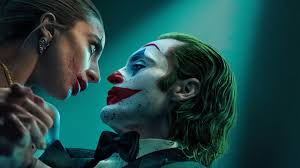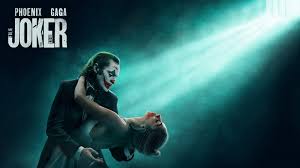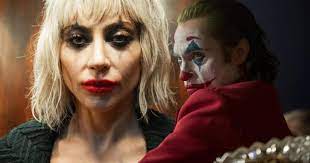Joker: Folie à Deux (2024)

Joker: Folie à Deux (2024) Review
The release of Joker in 2019 sent shockwaves through the cinematic world, reimagining the iconic DC villain with an unprecedented level of psychological depth and grit. With Joker: Folie à Deux (2024), director Todd Phillips returns to the chaotic world of Arthur Fleck, this time expanding his story in ways both unexpected and provocative. Featuring the return of Joaquin Phoenix as Arthur Fleck and the addition of Lady Gaga as Harley Quinn, the sequel is a bold and haunting exploration of madness, love, and shared delusion.
Plot Overview
Set shortly after the events of the first film, Joker: Folie à Deux begins with Arthur Fleck confined to Arkham State Hospital following his anarchic rise to infamy. Isolated and struggling with his inner demons, Arthur finds an unlikely connection with Dr. Harleen Quinzel (Lady Gaga), a psychiatrist assigned to his case. Over time, their sessions evolve into something darker as Arthur’s influence begins to unravel Harleen’s sanity.
As the pair descend into their shared madness, Harleen transforms into Harley Quinn, embracing her own chaotic persona. Together, they embark on a twisted journey that challenges societal norms and morality, culminating in a series of violent and theatrical events that further cement Joker’s place as Gotham’s most infamous figure. Meanwhile, the city itself becomes a character, teetering on the brink of collapse as political and social tensions escalate.
Performances
Joaquin Phoenix once again delivers a masterful performance as Arthur Fleck. Building on the foundation of his Oscar-winning portrayal, Phoenix takes Arthur’s descent into madness to new depths. His physicality, mannerisms, and ability to convey vulnerability and menace simultaneously make him an utterly compelling presence on screen. Arthur’s interactions with Harley are filled with tension and unpredictability, showcasing Phoenix’s ability to command attention even in the quietest moments.
Lady Gaga’s portrayal of Harley Quinn is nothing short of transformative. Departing from previous iterations of the character, Gaga brings a raw and grounded intensity to Harley’s evolution. Her chemistry with Phoenix is electric, oscillating between tenderness and volatility. Gaga’s background as a performer lends itself beautifully to the film’s musical elements, allowing her to blend vulnerability, theatricality, and menace seamlessly.
The supporting cast, including Zazie Beetz reprising her role as Sophie Dumond in a limited capacity, adds layers to the narrative. Brendan Gleeson and Catherine Keener also deliver standout performances as key figures in Gotham’s crumbling system, though their roles are more subdued compared to the central duo.
Visuals and Direction
Todd Phillips elevates the film’s aesthetic, building on the grimy, oppressive atmosphere of the original. Folie à Deux leans heavily into its psychological themes, using striking visuals and surreal sequences to blur the lines between reality and delusion. Gotham feels more claustrophobic than ever, its decaying streets mirroring Arthur and Harley’s unraveling psyches.
The film’s use of color and lighting is particularly noteworthy. Where the first Joker employed muted tones to reflect Arthur’s isolation, Folie à Deux incorporates splashes of vibrant reds and purples, symbolizing both the characters’ passion and their descent into chaos. The cinematography by Lawrence Sher captures this transformation beautifully, with dynamic framing that underscores the film’s themes of duality and madness.
Musical Elements
One of the most intriguing aspects of Folie à Deux is its musical component. Unlike a traditional musical, the film uses songs sparingly, integrating them into key moments to reflect the characters’ emotions and inner turmoil. Lady Gaga’s powerful vocals are a standout, particularly in a haunting duet with Phoenix that encapsulates their twisted relationship.
The score, composed by Hildur Guðnadóttir, builds on the melancholic themes of the original while introducing more whimsical and chaotic motifs. The music becomes a character in its own right, mirroring the film’s emotional highs and lows.
Themes and Subtext
At its core, Joker: Folie à Deux is an exploration of shared delusion, as its title—French for “madness of two”—suggests. The film delves into the toxic, symbiotic relationship between Arthur and Harley, examining how their shared pain and isolation fuel their descent into chaos. It’s a story about the power dynamics within relationships, the fragility of identity, and the human need for connection, no matter how destructive.
The film also continues the social commentary of its predecessor, reflecting on systemic failure and the consequences of neglecting mental health. Gotham serves as a microcosm for societal decay, with its unrest and inequality paralleling the personal struggles of its inhabitants.
Weaknesses
While Joker: Folie à Deux is undeniably ambitious, its heavy reliance on psychological and surreal elements may alienate some viewers. The pacing, particularly in the film’s second act, can feel uneven as it shifts between introspection and explosive action. Additionally, the film’s darker themes and graphic violence might prove too intense for some audiences, even those familiar with the tone of the first installment.
Final Thoughts
Joker: Folie à Deux is a daring and provocative sequel that expands on the themes and characters of its predecessor while carving out its own identity. Anchored by stellar performances from Joaquin Phoenix and Lady Gaga, the film pushes the boundaries of the comic book genre, blending psychological drama, musical elements, and unflinching social commentary.
Though not without its flaws, Joker: Folie à Deux cements its place as a bold and unforgettable entry in the DC cinematic universe. It’s a film that challenges viewers to confront uncomfortable truths while offering a darkly poetic exploration of love and madness. For those willing to take the plunge, it’s a journey into chaos that’s as mesmerizing as it is unsettling.